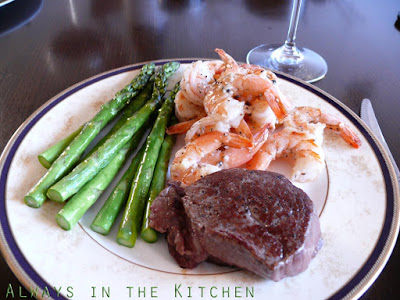 I adore mushrooms. I even like the little white button ones, although I'll admit that they aren't the most flavourful thing going on their own. That, after all, is what butter and garlic are for, right? Wild mushrooms are always a treat, and I manage to enjoy cultivated specialties such as the oyster mushroom, the portobello, the shiitake on a fairly regular basis. Once in a while, I spring for chantarelles, when I can, or black trumpets. Special occasions, those, decidedly.
I adore mushrooms. I even like the little white button ones, although I'll admit that they aren't the most flavourful thing going on their own. That, after all, is what butter and garlic are for, right? Wild mushrooms are always a treat, and I manage to enjoy cultivated specialties such as the oyster mushroom, the portobello, the shiitake on a fairly regular basis. Once in a while, I spring for chantarelles, when I can, or black trumpets. Special occasions, those, decidedly. My first dish, since I had more than enough for two meals, was a simple pasta - fettuccine tossed with a little garlic and cream, a little sauteed pancetta, and some butter-sauteed morels. Simplicity itself, really, even with a bit of parsley over top. It so happened that I had the pancetta on hand already, which largely decided the course of the dish. I also had some asparagus, but to my dismay discovered that it had hung about too long in the bottom of the crisper (I have not yet adapted to my new fridge, and its vagaries), and was no longer fit to eat. So, the originally planned dish would have been even more luxurious, if the asparagus had held up, but it was not to be.
My first dish, since I had more than enough for two meals, was a simple pasta - fettuccine tossed with a little garlic and cream, a little sauteed pancetta, and some butter-sauteed morels. Simplicity itself, really, even with a bit of parsley over top. It so happened that I had the pancetta on hand already, which largely decided the course of the dish. I also had some asparagus, but to my dismay discovered that it had hung about too long in the bottom of the crisper (I have not yet adapted to my new fridge, and its vagaries), and was no longer fit to eat. So, the originally planned dish would have been even more luxurious, if the asparagus had held up, but it was not to be.I have had morels before, of course - always as an accent to a dish where some other flavour held the supreme place of honour, and usually paired with other mushrooms, wild or domestic, to round things out a little. It is certainly an unaccustomed luxury that allows for making a dish that is devoted entirely to the morel itself. Arguably, the pancetta in my fettuccine was something of a distraction, flavour-wise, but the morel pieces themselves were plentiful enough that one certainly still got the sense that it was, essentially a mushroom dish.
Still, the purist in me, the girl that perked up upon reading Colette's assertion that morels should be eaten like the vegetable they are, simmered in champagne (!) for best effect, wanted to have a dish that not only highlighted the morel, but featured it in such wanton abundance that I could revel in morel flavour; in short, it would have to be a risotto.
 I cut the pieces larger than I did for the pasta dish. Some of them were only slit open lengthwise, to ensure that the interior was insect-free. Some were coarsely chopped - there were a few monsters in there, truly, almost suitable for stuffing! All of them were sauteed until just tender in good butter, and then I simply proceeded per my usual Wild Mushroom Risotto recipe, omitting the porcini, or indeed any other mushroom than the morel.
I cut the pieces larger than I did for the pasta dish. Some of them were only slit open lengthwise, to ensure that the interior was insect-free. Some were coarsely chopped - there were a few monsters in there, truly, almost suitable for stuffing! All of them were sauteed until just tender in good butter, and then I simply proceeded per my usual Wild Mushroom Risotto recipe, omitting the porcini, or indeed any other mushroom than the morel.Finally able to wallow unobstructed in morel flavour, I found it to be a curious sort of taste. It was earthy, certainly, but also...almost spicy? It is difficult to describe, but there was a sort of rich intensity to the flavour, while it still managed to remain subtle - almost familiar, but not in the way of other mushrooms. It evoked forest floor (in a good way), and trees, and at the same time was utterly unlike anything I have ever tasted before. The texture was mushroom-spongy, but in a good way. That is, if you like mushrooms, it was lovely, and if you find them an organoleptic nightmare, perhaps you should steer clear. The rough edges to the honeycomb caps made for an almost tripe-like look to the paler of the individual pieces, and sat strangely on the tongue before collapsing in buttery submission.
I'm looking forward to morels again next year - I suspect the season is truly over now, in the throes of July's suddenly summery heat - and perhaps next year, I will feel profligate enough to simmer my mushrooms in champagne, watching the bubbles dance through the honeycombed caps, as Colette assures us we must.















